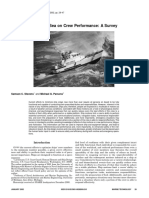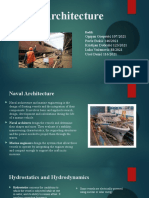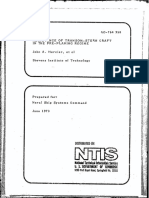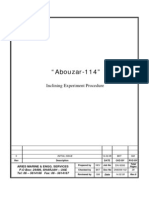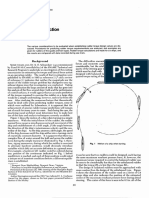Effect of Criteria On Seakeeping Performance Assessment
Effect of Criteria On Seakeeping Performance Assessment
Uploaded by
jarbas.otoniCopyright:
Available Formats
Effect of Criteria On Seakeeping Performance Assessment
Effect of Criteria On Seakeeping Performance Assessment
Uploaded by
jarbas.otoniOriginal Description:
Original Title
Copyright
Available Formats
Share this document
Did you find this document useful?
Is this content inappropriate?
Copyright:
Available Formats
Effect of Criteria On Seakeeping Performance Assessment
Effect of Criteria On Seakeeping Performance Assessment
Uploaded by
jarbas.otoniCopyright:
Available Formats
Ocean Engineering 32 (2005) 11611173
www.elsevier.com/locate/oceaneng
Effect of criteria on seakeeping
performance assessment
Kadir Sarioz*, Ebru Narli
Faculty of Naval Architecture and Ocean Engineering, Istanbul Technical University,
Maslak 34469, Istanbul, Turkey
Received 9 April 2004; accepted 8 December 2004
Available online 25 February 2005
Abstract
The overall performance of ships depends on the seakeeping performance in specified sea areas
where the vessel is designed to operate. The seakeeping performance procedure is based upon the
probability of exceeding specified ship motions in a sea environment particular to the vessels
mission. Given the operational area of the vessel, the percentage of time the vessel operates in a
particular sea state can be determined from an oceanographic database through application of the
response amplitude operators. The predicted motions are compared to the motion limiting criteria to
obtain the operability indices. However, the operability indices are strongly affected by the chosen
limiting criteria. This is particularly the case for passenger vessels where many conflicting criteria
are used to assess the effect of motions and accelerations on comfort and well-being of passengers.
This paper investigates the effect of seakeeping criteria on seakeeping performance assessment for
passenger vessels. Conventional seakeeping performance measures are evaluated for various levels
of vertical accelerations defined by the ISO 2631 standard. It is shown that the estimated seakeeping
performance of a passenger vessel greatly depends on the level of limiting value selected as the
seakeeping criteria.
q 2005 Elsevier Ltd. All rights reserved.
Keywords: Seakeeping; Seakeeping criteria; Motion sickness; Habitability
* Corresponding author. Tel.: C90 212 285 63 96; fax: C90 212 285 65 08.
E-mail addresses: sarioz@itu.edu.tr (K. Sarioz), narli@itu.edu.tr (E. Narli).
0029-8018/$ - see front matter q 2005 Elsevier Ltd. All rights reserved.
doi:10.1016/j.oceaneng.2004.12.006
1162
K. Sarioz, E. Narli / Ocean Engineering 32 (2005) 11611173
1. Introduction
Most passenger vessels are designed to operate in an environment which can be hostile
due to winds and waves. Regardless of the type or size of these vessels, the well-being of
passengers will be degraded by the adverse effects of the environment. Therefore, the
technological success of passenger vessels hinges upon a good seakeeping design. It
should be the objective of the designer to minimise this degradation and ensure that the
safety of passengers on board is achieved.
The seakeeping performance of a passenger ship can be defined in terms of the average
fraction of time that the actual motions and accelerations are below specified levels
(habitability). An improvement in habitability will obviously improve the well being and
safety of both the passengers and crew on board.
The assessment of seakeeping performance of a passenger vessel in a specified sea
environment is related to four factors:
the wave response characteristics of the ship which depends on the size, dimensions,
form, and weight distribution characteristics
the nature of the sea environment
the ships speed and heading which determine how the ship will encounter the
environment, and
the quantitative and qualitative requirements for the well being and safety of passengers
and crew on board, i.e. the seakeeping criteria
The way these components interact will determine the habitability of the vessel.
It is now common practice to predict the seakeeping responses of a new design in
specified sea areas by using 2D or 3D analytical methods and a wide range of seakeeping
software are commercially available. The main difficulty in seakeeping performance
assessment is, generally, to determine the magnitude of seakeeping responses which will
cause degradation of performance.
Operational consequences of seakeeping performance for a passenger vessel are closely
related to vertical and lateral accelerations. The effect of vertical accelerations on humans
is well understood and has been incorporated into International Standard ISO (1985,
1997). The standard provides severe discomfort boundaries for motion sickness as a
function of acceleration level, the frequency of acceleration, and the duration of exposure
to the acceleration.
Besides the international standard, other measures could also be employed. These
measures include motion sickness incidence (MSI) parameter (OHanlon and McCauley,
1974) which reports the percentage number of people who will become motion sick at a
given acceleration level, frequency, and duration of exposure, and motion induced
interruptions (MIIs) (Graham, 1990) which represent the number of loss-of-balance events
which occur during an arbitrary deck operation.
In order to illustrate the effect of chosen seakeeping criteria on seakeeping performance
assessment, a 50-m motoryacht is considered. Main particulars and body plan of the vessel
are presented in Table 1 and Fig. 1, respectively.
K. Sarioz, E. Narli / Ocean Engineering 32 (2005) 11611173
1163
Table 1
Main particulars of the vessel
Length overall (LOA)
Length between perpendiculars (LBP)
Beam (B)
Draught (T)
Displacement (D)
Block coefficient (CB)
Midship section coefficient (CM)
Prismatic coefficient (CP)
Waterplane area coefficient (CWP)
Longitudinal centre of buoyancy (LCB)
Design speed
49.90 m
43.10 m
9.75 m
2.75 m
558.1 t
0.485
0.696
0.697
0.821
5.5%L (aft)
17 knots
The presentation of paper begins with an overview of seakeeping performance
assessment procedure. This procedure is first used to predict seakeeping responses of the
vessel in specified sea states. The habitability in each state is then estimated for a range of
acceleration levels described by the international standard as the threshold value for
varying levels of discomfort. For each acceleration level, the habitability is evaluated for a
range of forward speed and wave headings. The effect of selected acceleration levels on
seakeeping performance is described as a function of the habitability index.
2. Seakeeping performance assessment
The assessment of a marine vehicles seakeeping performance is based on the character
of its oscillations in the sea states it is expected to encounter during its operating life. Fig. 2
illustrates an overview of the seakeeping performance assessment procedure. The
procedure starts with prediction of the hydrodynamic response characteristics of the vessel
for a range of speed and heading values. The magnitude of the motions in seas of varying
Fig. 1. Body plan of the vessel.
1164
K. Sarioz, E. Narli / Ocean Engineering 32 (2005) 11611173
Fig. 2. Overview of the seakeeping performance assessment procedure.
severity can then be predicted, utilising wave spectra representative of the selected
operational sea area. Finally, the habitability of the vessel can be estimated, based on the
probability of ship motions remaining within acceptable limits.
The steps required to complete such analysis are described in the following sections.
K. Sarioz, E. Narli / Ocean Engineering 32 (2005) 11611173
1165
2.1. Ship response characteristics
The first step in the assessment of seakeeping performance is usually to determine the
motion response amplitudes and phases in the frequency domain for all six degrees of
freedom. Response Amplitude Operators (RAOs) are then computed for each critical
mode of motion, i.e. angular motion or translation of any point on the vessel, in terms of
displacement, velocity or acceleration. The RAOs define the amplitude of the response due
to a unit wave excitation.
Heave, pitch and roll require particular mention because they are three motions with
hydrostatic restoring and therefore possess natural response periods and the potential for
resonance behaviour. For a passenger vessel vertical and lateral accelerations are of main
concern due to the effect of accelerations on the comfort and well being of the passengers.
Fig. 3 shows typical vertical acceleration transfer functions in head seas as a function of
wave frequency and forward speed.
2.2. Definition of the seaway
The regular waves are seldom found in nature and hence the RAOs are of little
consequence on their own. The natural seaway in which a ship operates can only be
described by means of a statistical model. The spectrum or spectral density function is the
primary device used for representing the seaway and the oscillatory response of the vessel
to the seaway.
The wave characteristics of an area must be known in terms of the distribution of wave
energy with respect to frequency and direction, as well as the severity of seas as indicated
Fig. 3. Vertical acceleration RAOs (in passenger saloon) in head seas.
1166
K. Sarioz, E. Narli / Ocean Engineering 32 (2005) 11611173
Fig. 4. One parameter representation of spectral density distribution.
by the wave height probability distributions. The wave energy distribution within various
wave height bands can be represented through the use of a wave spectral family. In Fig. 4
spectral density functions are presented as a function of wave frequency and sea state,
based on the one parameter PiersonMoskowitz formulation.
2.3. Prediction of responses in a specified seaway
The short-term response trends obtained by superposition of the vessel RAOs with the
wave spectral family describe the mean steady-state response amplitudes for seas of
varying severity, as well as the standard deviation about the mean due to variations in
spectral shape within each wave height group.
A typical result for vertical accelerations in passenger lounge in head seas is presented
in Fig. 5. These results are based on calculations for a speed range of 017 knots and a sea
state range of 26.
These calculations must be performed for all headings and for each seakeeping
response which may affect the performance of the vessel. Typical examples are shown in
Figs. 6 and 7. In these figures the root mean square (RMS) vertical acceleration levels
(m/s2) in passenger saloon are plotted for a range of headings from head seas to following
seas, for sea states 5 and 6. The acceleration levels are selected in accordance with levels
described by the ISO 2631 standard for different exposure times. Circles in the figures
represent forward speed while the radial lines represent the wave heading.
K. Sarioz, E. Narli / Ocean Engineering 32 (2005) 11611173
1167
Fig. 5. The variation of vertical accelerations with speed and sea state in head seas.
2.4. Seakeeping criteria
In order to assess the effect of seakeeping performance on the mission capability of the
vessel the mission requirements need to be translated into seakeeping performance
requirements. However, there is no distinct universal set of criteria for seakeeping
performance. The criteria can vary vastly from ship to ship depending on the missions of
the ship.
An important key to the acceptability of a passenger vessel is the ride comfort
expressed as a low percentage of passengers getting seasick in rough seas. Vertical and
lateral accelerations are mainly responsible for seasickness.
Table 2 presents a tentative scale for vertical acceleration, which may be used for
estimating the maximum acceptable magnitude for different activities on board and for the
comfort of the crew and the passengers.
Typical performance criteria for personnel performance in a warship are listed in
Table 3. These criteria are given as significant single amplitude which is the average of the
one-third of highest amplitudes and is close to what the trained observer would estimate
the motions to be.
The concept of Motion Sickness Indicator (MSI) was developed in a study
sponsored by the US Navy in the early 1970s to investigate the effect on humans of
ship motions (OHanlon and McCauley, 1974). The research attempted to quantify the
incidence of actual vomiting (emesis) of a group (over 500) of young men,
unacclimatized to motions, subjected to vertical sinusoidal vertical motion of various
amplitudes at a series of single frequencies. The range of RMS acceleration and
frequency was selected as 0.275.5 m/s 2 and 0.0830.700 Hz, respectively.
1168
K. Sarioz, E. Narli / Ocean Engineering 32 (2005) 11611173
Fig. 6. Speed polar diagram of RMS vertical acceleration in sea state 5.
The experiments showed that the occurrence of emesis was correlated with both
acceleration and frequency and, using empirical data, a motion sickness incidence
relationship was derived. The MSI value indicates the percent of subjects that
experienced emesis in a 2-h test period. According to the test data, people have
significantly less tolerance to vertical motion in the 0.20.16 Hz (56 s) range than at
higher or lower frequencies. This is in accordance with experience on ships at sea.
Results of these experiments are often expressed in terms of the acceleration level
found to cause 10% of the subjects to become physically ill when subjected to such
motions for a specified time interval. It should be noted that, the validity of the MSI is tied
to the many constraints imposed by the laboratory environment. The subjects used in the
experiment were all healthy young college males, unacclimated to any form of shipboard
motion. Furthermore, the effect of roll and pitch motions are ignored.
Motion induced interruptions (MIIs) represent the number of loss-of-balance events
which occur during an arbitrary deck operation (Graham, 1990). It was shown that the
incidence of MIIs could be related to a concept of lateral force estimator (LFE), which is a
combination of the earth-referenced lateral acceleration and the ship-referenced lateral
acceleration due to roll motion. This greatly reduces computational efforts since the LFE
K. Sarioz, E. Narli / Ocean Engineering 32 (2005) 11611173
1169
Fig. 7. Speed polar diagram of RMS vertical acceleration in sea state 6.
Table 2
Limiting criteria for vertical acceleration (Odabas et al., 1991)
Vertical RMS
acceleration (g)
Description
0.020
Passengers on a cruise liner. Older people. Close to the lower threshold below which
vomiting is unlikely
Passengers on a ferry. The international standard for 2 h exposure period. Causes symptoms
of motion sickness in approximately 10% of unacclimatized adults
Intellectual work by people reasonably well adapted to ship motions (i.e. scientific personnel
on ocean research vessels). Cognitive/manual work of a more demanding nature. Long term
tolerable for the crew. The international standard for half an hour exposure period
Heavy manual work by people adapted to ship motions: for instance on fishing vessels and
supply ships
Light manual work by people adapted to ship motions. Not tolerable for longer periods.
Quickly causes fatigue
Simple light work. Most of the attention must be devoted to keeping balance. Tolerable only
for short periods on high-speed craft
0.050
0.100
0.150
0.200
0.275
1170
K. Sarioz, E. Narli / Ocean Engineering 32 (2005) 11611173
Table 3
Typical personnel performance criteria for warships
Application
Motion
Limit
Location
General
Vertical Acceleration
Lateral Acceleration
MSI
MII
0.4 g
0.2 g
20% of personnel
1/min
Bridge
Bridge
Task location
Task location
Specific Task
Fig. 8. ISO 2631 severe discomfort boundaries.
K. Sarioz, E. Narli / Ocean Engineering 32 (2005) 11611173
1171
value can be calculated in the frequency domain. Implicit in the LFE concept is the
assumption that the ship-referenced vertical acceleration is negligible; hence, the LFE is
only a valid estimator of MIIs under conditions in which the vertical acceleration is small.
The main source of criteria on motion sickness is the International Standard ISO 2631
(ISO 2631-3, 1985). ISO standard 2631/3/1985 covers vertical vibration in the frequency
range 0.10.63 Hz and links the factors of vertical acceleration, exposure time and
frequency, and provides severe discomfort boundaries in terms of the RMS vertical
acceleration for different exposure times as a function of the centre frequency of one-third
octave band, as shown in Fig. 8. This forms an ideal basis for the analysis of motion
sickness on ships.
Experimental observations indicate that the greatest sensitivity to vertical accelerations
is in the range of 0.1250.25 Hz with a rapid reduction in sensitivity at higher frequencies.
Above 0.315 Hz, the severe discomfort boundary defined by ISO 2631/3 increases by the
rate of 10 dB per octave.
The field data indicates that about 10% of the passengers will be seasick when the root
mean square (RMS) acceleration is 0.5 m/s2 (approximately 0.05 g significant) which is
also the ISO-boundary for an exposure period of two hours in the frequency range
0.10.315 Hz.
As shown in Fig. 8, depending on exposure time and frequency of oscillation, different
values of RMS vertical acceleration could be selected as seakeeping criteria. This would
result in different levels of habitability for the same sea conditions. The effect of selected
acceleration levels on habitability assessment is illustrated in the following section.
3. Habitability assessment
For each combination of speed, heading, and sea state, seakeeping performance can be
assessed using the speed polar diagram concept. In the diagram a set of limiting criteria is
used to define an area of ship speed and relative heading combinations within which
particular missions can be executed without violating any of the limiting criteria. The ratio
of the habitable area to the area of the polar plot defines an Habitability Index for the ship,
seaway and sea state being considered.
In order to illustrate the effect of chosen criteria on habitability, the vertical
accelerations at the passenger saloon were calculated for sea states 5 and 6 with
corresponding significant wave height values of 3.25 and 5 m, respectively. Speed polar
diagrams on the basis of different levels of RMS vertical accelerations, specified by ISO
Table 4
The selected levels of accelerations
Exposure time
RMS acceleration (m/s2)
8h
4h
2h
1h
30 min
0.250
0.315
0.500
0.707
1.000
1172
K. Sarioz, E. Narli / Ocean Engineering 32 (2005) 11611173
Fig. 9. Habitability indices as a function of selected limiting acceleration level.
2631 as a function of exposure time, are shown in Figs. 6 and 7. The selected levels of
accelerations are defined in Table 4.
As shown in the speed polar diagrams the level of RMS vertical acceleration
significantly affect the estimated habitability. For this vessel, in sea states 5 and 6,
the estimated habitability based on vertical accelerations at passenger saloon are shown
in Fig. 9.
4. Concluding remarks
The assessment of seakeeping performance of a vessel in a specified sea area is a
common computational procedure for which a typical example is presented in this paper.
This procedure requires the prediction of transfer functions for different speed and
headings for each response. These transfer functions are then combined with an
appropriate spectral formulation based on the sea area characteristics. The results are
presented in a polar format where for each speed and heading combinations the variation
of motion characteristics with increasing sea state can be established. Provided that a set of
reliable seakeeping criteria are available the habitability of the vessel in different sea states
can be estimated.
However, there are no universally agreed criteria for comparing the seakeeping
performance of alternative designs. For passenger ships, the criteria are dominated by
K. Sarioz, E. Narli / Ocean Engineering 32 (2005) 11611173
1173
vertical and lateral accelerations. ISO 2631 provides severe discomfort boundaries as a
function of frequency and exposure time. The results indicate that even slight variations in
exposure time may result in significant differences in estimated habitability. Hence, the
methods currently used for comparing the seakeeping capabilities of ships can be
misleading.
It is shown in the paper that, the estimated habitability of a passenger vessel in a
specified sea area strongly depends on the selected limiting acceleration level. Therefore,
particularly in comparative seakeeping analyses, the chosen set of criteria and its
parameters must specifically be described in order to provide reliable seakeeping
performance information.
References
Graham, R., 1990. Motion induced interruptions as ship operability criteria. Naval Engineers Journal 102 (2).
ISO, 1985. Evaluation of Human Exposure to Whole-body VibrationPart 3: Evaluation of Whole-body z-axis
Vertical Vibration in the Frequency Range 0.1 to 0.63 Hz.
ISO, 1997. Mechanical Vibration and Shock Evaluation of Human Exposure to Whole Body VibrationPart 1:
General Requirements.
Odabas A.Y., Fitzsimmons P.A., Ankudinov V.K., Wiley S.A., 1991. Seakeeping Considerations in Ship Design
and Their Incorporation in HDDS. BMT International, Report No. HDDS.P2.SPEC.
OHanlon, J.F., McCauley, M.E., 1974. Motion sickness as a function of the frequency and acceleration of
vertical sinusoidal motion. Aerospace Medicine 45 (4), 366369.
You might also like
- NM209 - Marine Design Production - v01Document123 pagesNM209 - Marine Design Production - v01Euclides CagniniNo ratings yet
- E336 2005Document11 pagesE336 2005Chingalata Costel100% (1)
- Thumb Rule For Selection of Vibro HammerDocument4 pagesThumb Rule For Selection of Vibro Hammerlspartha100% (1)
- Belenky, Vadim Sevastianov, Nikita B. Stability and Safety of Ships - Risk of Capsizing 2007Document455 pagesBelenky, Vadim Sevastianov, Nikita B. Stability and Safety of Ships - Risk of Capsizing 2007Mai Kawayapanik100% (1)
- Naval Innovation for the 21st Century: The Office of Naval Research Since the End of the Cold WarFrom EverandNaval Innovation for the 21st Century: The Office of Naval Research Since the End of the Cold WarNo ratings yet
- Wireline OperationDocument90 pagesWireline Operationjarbas.otoni88% (8)
- Electrochlor Ination System Operating and MaintenanceDocument50 pagesElectrochlor Ination System Operating and Maintenancejarbas.otoni75% (4)
- 1996-2001 Ford Explorer PDFDocument5,564 pages1996-2001 Ford Explorer PDFNazael Diaz80% (5)
- Physics Workbook 12 GradeDocument23 pagesPhysics Workbook 12 GradeGarin RahmatNo ratings yet
- Instruction Book Iqan-Xa2: Publ No HY17-8385-IB/UK Edition 0505Document38 pagesInstruction Book Iqan-Xa2: Publ No HY17-8385-IB/UK Edition 0505Munawar DoankNo ratings yet
- Sea Keeping Analysis For Preliminary DesignDocument10 pagesSea Keeping Analysis For Preliminary DesignTullio OpattiNo ratings yet
- Effects of Motion at Sea On Crew Performance - Stevens & Parsons - 2002 PDFDocument19 pagesEffects of Motion at Sea On Crew Performance - Stevens & Parsons - 2002 PDFSurya Chala PraveenNo ratings yet
- Poor Vika ReportDocument70 pagesPoor Vika Reportpoorvikaojha2504No ratings yet
- Equipment Number Calculation Rules - IRSDocument5 pagesEquipment Number Calculation Rules - IRSmaaathanNo ratings yet
- Passing Ship FloryDocument12 pagesPassing Ship FloryPeyman MznNo ratings yet
- 11 Naval Architecture 2Document6 pages11 Naval Architecture 2Ognjen GospavicNo ratings yet
- ADA022379 - Tenth Symposium On Naval HydrodynamicsDocument791 pagesADA022379 - Tenth Symposium On Naval HydrodynamicsYuriyAK100% (2)
- Stability Booklet 80m UVSS Rev C PDFDocument65 pagesStability Booklet 80m UVSS Rev C PDFGenevieveBeckNo ratings yet
- Powering and Propulsion: Lectures ONDocument61 pagesPowering and Propulsion: Lectures ONbovingNo ratings yet
- System Based Ship Design, Kai LevanderDocument22 pagesSystem Based Ship Design, Kai LevanderAlex IrieBobNo ratings yet
- Thesis RGdeJongDocument108 pagesThesis RGdeJongNaval2014DNNo ratings yet
- Resistance of Transom-Stern Craft in The Pre-Planing RegimeDocument104 pagesResistance of Transom-Stern Craft in The Pre-Planing RegimeNick ChappleNo ratings yet
- Ship Resistance CalculationDocument11 pagesShip Resistance CalculationBhagatsinh Geda100% (6)
- Naval Architect Project ReportDocument62 pagesNaval Architect Project Reportanuxcool100% (3)
- Design and Simulation of Marine Propeller With Different Blade GeometryDocument9 pagesDesign and Simulation of Marine Propeller With Different Blade GeometryInternational Journal of Innovative Science and Research Technology100% (1)
- Hull Performance and Insight Conference PDFDocument314 pagesHull Performance and Insight Conference PDFromeo baveraNo ratings yet
- ShaftDesigner by IMT (English)Document2 pagesShaftDesigner by IMT (English)Monglen Z. Casiño100% (1)
- DownloadDocumentFile - Ashxdownload DocumentDocument12 pagesDownloadDocumentFile - Ashxdownload DocumentRida FatimaNo ratings yet
- TheFutureOfShipDesign Part1Document169 pagesTheFutureOfShipDesign Part1cesare100% (2)
- Optimoor: Mooring Analysis So Ware For Ships & BargesDocument2 pagesOptimoor: Mooring Analysis So Ware For Ships & BargesTam Jun HuiNo ratings yet
- Full Scale Wake Prediction of An Energy Saving Device by Using Computational Fluid DynamicsDocument10 pagesFull Scale Wake Prediction of An Energy Saving Device by Using Computational Fluid DynamicsChristoper MochengoNo ratings yet
- Risk Assessment of Aging Ship Hull Structures - FatigueDocument21 pagesRisk Assessment of Aging Ship Hull Structures - FatiguetrollgueleNo ratings yet
- Sea Keeping LectureDocument66 pagesSea Keeping Lecturevzagkas100% (4)
- MSC 337Document36 pagesMSC 337Alfred Esquillio MontealtoNo ratings yet
- Tonnes General Cargo (Ramakrishna)Document32 pagesTonnes General Cargo (Ramakrishna)Rama KrishnaNo ratings yet
- Konstruksi Kapal IIDocument52 pagesKonstruksi Kapal IIVivin Novita Sari SuwaryonoNo ratings yet
- Inclining Test Procedure-ExampleDocument28 pagesInclining Test Procedure-Exampletalabiz50% (2)
- Exercicio KT-J2 MICHIGAN 2016 PDFDocument4 pagesExercicio KT-J2 MICHIGAN 2016 PDFLucas VieiraNo ratings yet
- Integrated Hull Construction Outfitting and Painting (IHOP) - 2.dioDocument33 pagesIntegrated Hull Construction Outfitting and Painting (IHOP) - 2.diocappoxNo ratings yet
- KS-0179-1E Procedure Inclining TestDocument11 pagesKS-0179-1E Procedure Inclining TestSabri AlkanNo ratings yet
- SSC-436 The Effect of Fabricaton Tolerances On Fatigue Life of Welded JointsDocument100 pagesSSC-436 The Effect of Fabricaton Tolerances On Fatigue Life of Welded JointsBeniamine SarmientoNo ratings yet
- The Dynamics of Mooring Systems PDFDocument141 pagesThe Dynamics of Mooring Systems PDFMirsoNo ratings yet
- INA Problems 2Document6 pagesINA Problems 2siddarth amaravathiNo ratings yet
- Guidance For Naval ArchitectsDocument44 pagesGuidance For Naval Architectsliao_marco100% (1)
- Ship DynamicsDocument82 pagesShip Dynamicsthenavaler100% (2)
- Stability Booklet - Simpsion - IDocument30 pagesStability Booklet - Simpsion - IKiran KumarNo ratings yet
- Strength of A ShipDocument8 pagesStrength of A ShiphutsonianpNo ratings yet
- JMS SNAME Paper 2010-1Document10 pagesJMS SNAME Paper 2010-1hgmNo ratings yet
- ENGR 4011 Resistance & Propulsion of Ships Assignment 3: 2018Document5 pagesENGR 4011 Resistance & Propulsion of Ships Assignment 3: 2018Luis De GraciaNo ratings yet
- Channel Design and Vessel ManeuverabilityDocument18 pagesChannel Design and Vessel ManeuverabilityRodrigo Villas BôasNo ratings yet
- Ship Stability & Draft SurveyDocument33 pagesShip Stability & Draft SurveyAnanda Amalina100% (2)
- WP 2 - Report 4 - Resistance and Propulsion Power - FINAL - October 2012Document52 pagesWP 2 - Report 4 - Resistance and Propulsion Power - FINAL - October 2012jimmyy90No ratings yet
- Document FileDocument68 pagesDocument Fileso100% (1)
- Visualization of The Bubble Sweep-Down Phenomenon Around The Bow of A Ship ModelDocument13 pagesVisualization of The Bubble Sweep-Down Phenomenon Around The Bow of A Ship ModelAnthonyNo ratings yet
- 6.6 Interaction Between A Hull & A Propeller: in Which The Propeller Is Working? (Later We Will Also Study TheDocument31 pages6.6 Interaction Between A Hull & A Propeller: in Which The Propeller Is Working? (Later We Will Also Study Thebehzad parsiNo ratings yet
- Estimation of Added Resistance and Ship Speed Loss PDFDocument12 pagesEstimation of Added Resistance and Ship Speed Loss PDFAnant AjithkumarNo ratings yet
- Seakeeping RAODocument5 pagesSeakeeping RAOEgwuatu UchennaNo ratings yet
- Amecrc PDFDocument17 pagesAmecrc PDFshimul2008No ratings yet
- Estimation of Added Resistance and Ship Speed Loss in A SeawayDocument12 pagesEstimation of Added Resistance and Ship Speed Loss in A SeawayJoaNo ratings yet
- Rationally-Based Fatigue Design of Tankers (Owen Hughes and Paul FranklinDocument17 pagesRationally-Based Fatigue Design of Tankers (Owen Hughes and Paul FranklinKelvin XuNo ratings yet
- Wave Load Predictions For Marine Structures: Key WordsDocument17 pagesWave Load Predictions For Marine Structures: Key WordspothirajkalyanNo ratings yet
- Seakeeping Navigation Example TrimaranDocument15 pagesSeakeeping Navigation Example TrimaransiswoutNo ratings yet
- Sname JSR 2020 64 2 127Document12 pagesSname JSR 2020 64 2 127Gabriel EduardoNo ratings yet
- Journee SteeringDocument21 pagesJournee SteeringsorenvinNo ratings yet
- Common Damages On TailshaftDocument6 pagesCommon Damages On TailshaftStathis MoumousisNo ratings yet
- Oe 72 (2013) 453 SRS, CGSDocument17 pagesOe 72 (2013) 453 SRS, CGSsbnrs68No ratings yet
- Modu PDFDocument40 pagesModu PDFjarbas.otoniNo ratings yet
- Unit 2 Lesson 4 Casing and CementingDocument118 pagesUnit 2 Lesson 4 Casing and Cementingjarbas.otoni100% (1)
- Ship and Offshore Structures Congress PDFDocument925 pagesShip and Offshore Structures Congress PDFjarbas.otoni100% (1)
- What A Marine Surveyor Needs To Know About Working in Enclosed SpacesDocument81 pagesWhat A Marine Surveyor Needs To Know About Working in Enclosed Spacesjarbas.otoni100% (1)
- Hull SurveysDocument122 pagesHull Surveysjarbas.otoniNo ratings yet
- MSC Circ 0913Document11 pagesMSC Circ 0913jarbas.otoniNo ratings yet
- An Introduction To Salome & Code - Aster: A Simple Linear Statics Analysis of A PistonDocument23 pagesAn Introduction To Salome & Code - Aster: A Simple Linear Statics Analysis of A Pistonjarbas.otoniNo ratings yet
- 4 Standing Waves & Doppler EffectDocument6 pages4 Standing Waves & Doppler EffectrebbiegNo ratings yet
- Formative Assessment 6Document1 pageFormative Assessment 6bashadelacruz7No ratings yet
- Radiology Physics 1Document11 pagesRadiology Physics 1Sharifa AbdulghaffarNo ratings yet
- Bearing Failure Detection On An Air Compressor: Case HistoryDocument2 pagesBearing Failure Detection On An Air Compressor: Case HistoryHéctor Rivera100% (1)
- Notes On 150Mhz and DNADocument5 pagesNotes On 150Mhz and DNAoscarnine100% (1)
- A Quick Tutorial On LabVIEW Data AcquisitionDocument12 pagesA Quick Tutorial On LabVIEW Data Acquisitionmino3089389No ratings yet
- Notes On Wave Motion 12Document4 pagesNotes On Wave Motion 12Gamela MoonoNo ratings yet
- Tesis Damian TDocument359 pagesTesis Damian TpalfrancaNo ratings yet
- Vibration Learning 1Document51 pagesVibration Learning 1mubashirNo ratings yet
- ASP ESME Introduction2 2022Document22 pagesASP ESME Introduction2 2022MédéricGuyon GuyonNo ratings yet
- Experiment 2 Manual - Speed of Sound PDFDocument12 pagesExperiment 2 Manual - Speed of Sound PDFs-mohammed_hussein100% (1)
- Nerc'S New Control Performance Stand: Nasser Jaleelit and LouisDocument8 pagesNerc'S New Control Performance Stand: Nasser Jaleelit and LouisWoody Tzen ThamNo ratings yet
- Air MasterDocument31 pagesAir MasterprasathinusaNo ratings yet
- Active and Passive Filter CircuitsDocument10 pagesActive and Passive Filter CircuitsDavid.R.Gilson88% (8)
- Module 3 VANDERZANDERDocument4 pagesModule 3 VANDERZANDERpeter vanderNo ratings yet
- A318 Airbus: ATA 24 Electrical PowerDocument27 pagesA318 Airbus: ATA 24 Electrical PowerGiáo ViênNo ratings yet
- Vibration Field Tehcnician GuideDocument21 pagesVibration Field Tehcnician Guidebudiharyatno100% (1)
- Frequency Control Free Governor Operation: PresentationDocument16 pagesFrequency Control Free Governor Operation: PresentationHartoyoNo ratings yet
- Users Manual: Sgp10Xxs Series Direct Digital Synthesis (DDS) Signal GeneratorDocument7 pagesUsers Manual: Sgp10Xxs Series Direct Digital Synthesis (DDS) Signal GeneratorCarbon Nano TubeNo ratings yet
- Acoustic WavesDocument7 pagesAcoustic WavesjoeregueNo ratings yet
- 3.9.1 Sound Echo Set 1 QP MsDocument2 pages3.9.1 Sound Echo Set 1 QP Msdiyakrishna202010No ratings yet
- Construction Materials For Acoustic DesignDocument35 pagesConstruction Materials For Acoustic DesignRukminiPriyanka100% (1)
- Model No.: M195Fge Suffix: L20: Product SpecificationDocument29 pagesModel No.: M195Fge Suffix: L20: Product SpecificationJosé Daniel Rodríguez AvilaNo ratings yet
- t600 TachometerDocument5 pagest600 Tachometerwriteandrewpaul7707No ratings yet
- Parts of A Wave 1Document19 pagesParts of A Wave 1Joshua LaraNo ratings yet











